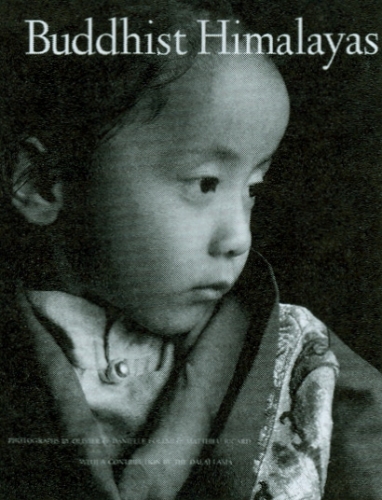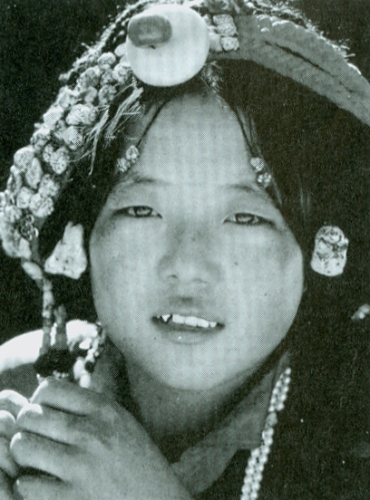Buddhist Himalayas
Photographs by Oliver and Danielle Föllmi and Matthieu Ricard
New York: Abrams, 2002
423 pp.; $55.00 (cloth)
Spacious landscapes move us. Why? Because we ourselves are, in essence, the moving center of an infinite openness. This metaphor animates the traditions of Buddhism that flourish, even now, in the snowy expanses of the Himalayas. If you’ve ever journeyed to these lands, you know how difficult it is to recount to others the sublime splendor of their scale, and especially the interplay of outer landscape and horizon with the intimate spaces of one’s spiritual life. Well, thanks to the collaborative vision of a group of well-known photographers and scholars, we now have an archive that evokes these expanses of space and spirit.
Buddhist Himalayas is a breakthrough cultural achievement, a visual and textual treasure faithful to the living heritage of those spiritual traditions that took root and flowered in Nepal, Ladakh, Zangskar, Bhutan, Sikkim, and Tibet. And it is so much more than what is usually conjured in our minds by the word “book.” It is a performance piece in four hundredsequences (“pages”), which has as its theme the physical grandeur, cultural richness, and political fragility of contemporary Buddhism in the Himalayas. It moves us, with image and word, through an astonishing range of contemporary Buddhist cultural tableaux. If one slowly turns the pages of this volume and opens to the myriad landscapes and candid portraits of everyday life among those whose “Buddhism” is in their heart and bones,Buddhist Himalayas becomes a slide show of enduring beauty.
 The artistic conception of the work is at once grand and subtle, informed by the efforts of three veteran observers seasoned in the nuances of recording the living context of Buddhism—the Buddhist monk and scholar Matthieu Ricard, in collaboration with the husband-and-wife photographic team of Danielle and Olivier Föllmi. A glance at the table of contents for Buddhist Himalayas reveals that it works on at least three levels. First is the meta-level—the implicit schema—of birth, living, dying, and rebirth. This theme is intimately woven into the fabric of the volume in recounting the childhood, life, and death of the spiritual master H.H. Dilgo Khyentse Rinpoche (1910-1991), and the subsequent recognition of his rebirth as Urgyan Tenzin Jigme Lhundrub. Second, the book is organized according to ten major headings, which together address major elements of the Himalayan world: the value of life; the importance of the dharma; the connection between land and people; the rich heritage of performative, healing, and wisdom traditions; and, too, the physical and cultural destruction of the past half-century. Third, grouped within these headings are almost sixty scholarly articles, written by world-renowned experts in the fiel ds of medicine, astrology, ethnomusicology, social anthropology, political science, music, language, and literature.
The artistic conception of the work is at once grand and subtle, informed by the efforts of three veteran observers seasoned in the nuances of recording the living context of Buddhism—the Buddhist monk and scholar Matthieu Ricard, in collaboration with the husband-and-wife photographic team of Danielle and Olivier Föllmi. A glance at the table of contents for Buddhist Himalayas reveals that it works on at least three levels. First is the meta-level—the implicit schema—of birth, living, dying, and rebirth. This theme is intimately woven into the fabric of the volume in recounting the childhood, life, and death of the spiritual master H.H. Dilgo Khyentse Rinpoche (1910-1991), and the subsequent recognition of his rebirth as Urgyan Tenzin Jigme Lhundrub. Second, the book is organized according to ten major headings, which together address major elements of the Himalayan world: the value of life; the importance of the dharma; the connection between land and people; the rich heritage of performative, healing, and wisdom traditions; and, too, the physical and cultural destruction of the past half-century. Third, grouped within these headings are almost sixty scholarly articles, written by world-renowned experts in the fiel ds of medicine, astrology, ethnomusicology, social anthropology, political science, music, language, and literature.
These textual entries alone would make the volume worthy of purchase, a cultural feast of Himalayan learning. Over half the essays were written by Matthieu Ricard, already known to scholars for his masterly translation of The Life of Shabkar, and to the general public for his collaborations with his father (The Monk and the Philosopher) and, most recently, with the astrophysicist Thrinh Xuan Thuan (The Quantum and the Lotus). He is also credited with many of the photographs.
Buddhist Himalayas contains essays by some of France’s greatest scholars: Corneille Jest on caravans, Mireille Helffer on music, and Fernand Meyer on medicine, among others. In addition, there are short essays by those already known to English-speaking students of Himalayan culture—E. Gene Smith on Tibetan literature, David Jackson on Tibetan painting, and Francoise Pommeret on Bhutan. Of special note are the essays by contemporary Tibetans themselves—Jetsun Pema on the education of Tibetan children, Jamyang Norbu (author of the award-winning novel The Mandala of Sherlock Holmes) on the case for Tibet’s independence, and, in conclusion, H.H. the Dalai Lama, on the future of Tibet.

One finds, interspersed throughout the volume, beautiful Tibetan calligraphy by the master calligrapher Jigme Douche. His graceful orange-red brushwork spaces the mantra syllables of compassion (om ma ni pa dme hum) and wisdom (om a ra pa tsa na dhih) throughout the pages of the essays. This is the key, I think, to the most subtle level of the volume’s vision, for compassion and wisdom are the primal energies of the spiritual teacher. Buddhist Himalayas begins with an essay on the spiritual teacher as the source of inspiration, followed by two short essays on embodiments of inspiration for our times—the exemplary manifestation of wisdom, in the life of the late H.H. Dilgo Khyentse Rinpoche, and that of compassion, in the life of H.H. the Dalai Lama.
This volume is a loving testament to the enduring force of the Buddha’s message, that though the flames of individual lives flicker and eventually go out, the inner flame of enlightened presence endures.